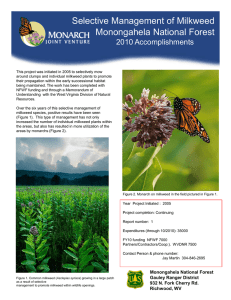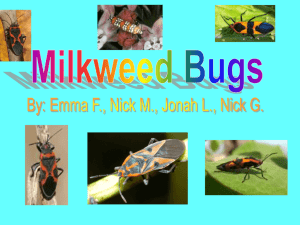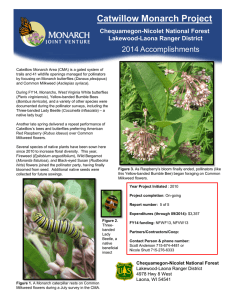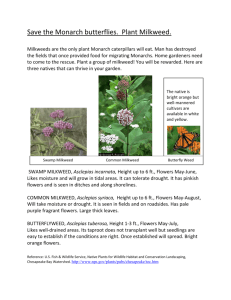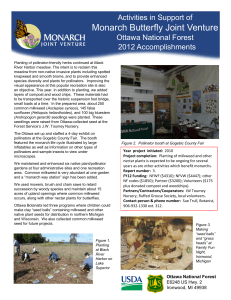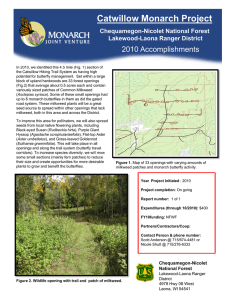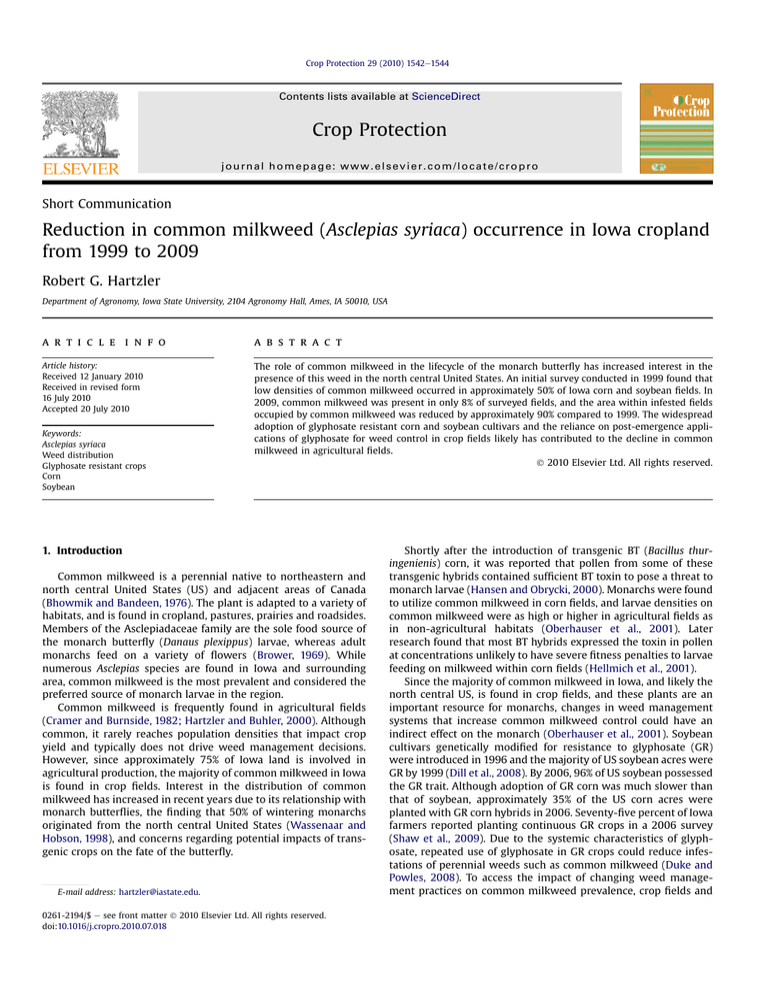
Crop Protection 29 (2010) 1542e1544
Contents lists available at ScienceDirect
Crop Protection
journal homepage: www.elsevier.com/locate/cropro
Short Communication
Reduction in common milkweed (Asclepias syriaca) occurrence in Iowa cropland
from 1999 to 2009
Robert G. Hartzler
Department of Agronomy, Iowa State University, 2104 Agronomy Hall, Ames, IA 50010, USA
a r t i c l e i n f o
a b s t r a c t
Article history:
Received 12 January 2010
Received in revised form
16 July 2010
Accepted 20 July 2010
The role of common milkweed in the lifecycle of the monarch butterfly has increased interest in the
presence of this weed in the north central United States. An initial survey conducted in 1999 found that
low densities of common milkweed occurred in approximately 50% of Iowa corn and soybean fields. In
2009, common milkweed was present in only 8% of surveyed fields, and the area within infested fields
occupied by common milkweed was reduced by approximately 90% compared to 1999. The widespread
adoption of glyphosate resistant corn and soybean cultivars and the reliance on post-emergence applications of glyphosate for weed control in crop fields likely has contributed to the decline in common
milkweed in agricultural fields.
Ó 2010 Elsevier Ltd. All rights reserved.
Keywords:
Asclepias syriaca
Weed distribution
Glyphosate resistant crops
Corn
Soybean
1. Introduction
Common milkweed is a perennial native to northeastern and
north central United States (US) and adjacent areas of Canada
(Bhowmik and Bandeen, 1976). The plant is adapted to a variety of
habitats, and is found in cropland, pastures, prairies and roadsides.
Members of the Asclepiadaceae family are the sole food source of
the monarch butterfly (Danaus plexippus) larvae, whereas adult
monarchs feed on a variety of flowers (Brower, 1969). While
numerous Asclepias species are found in Iowa and surrounding
area, common milkweed is the most prevalent and considered the
preferred source of monarch larvae in the region.
Common milkweed is frequently found in agricultural fields
(Cramer and Burnside, 1982; Hartzler and Buhler, 2000). Although
common, it rarely reaches population densities that impact crop
yield and typically does not drive weed management decisions.
However, since approximately 75% of Iowa land is involved in
agricultural production, the majority of common milkweed in Iowa
is found in crop fields. Interest in the distribution of common
milkweed has increased in recent years due to its relationship with
monarch butterflies, the finding that 50% of wintering monarchs
originated from the north central United States (Wassenaar and
Hobson, 1998), and concerns regarding potential impacts of transgenic crops on the fate of the butterfly.
E-mail address: hartzler@iastate.edu.
0261-2194/$ e see front matter Ó 2010 Elsevier Ltd. All rights reserved.
doi:10.1016/j.cropro.2010.07.018
Shortly after the introduction of transgenic BT (Bacillus thuringenienis) corn, it was reported that pollen from some of these
transgenic hybrids contained sufficient BT toxin to pose a threat to
monarch larvae (Hansen and Obrycki, 2000). Monarchs were found
to utilize common milkweed in corn fields, and larvae densities on
common milkweed were as high or higher in agricultural fields as
in non-agricultural habitats (Oberhauser et al., 2001). Later
research found that most BT hybrids expressed the toxin in pollen
at concentrations unlikely to have severe fitness penalties to larvae
feeding on milkweed within corn fields (Hellmich et al., 2001).
Since the majority of common milkweed in Iowa, and likely the
north central US, is found in crop fields, and these plants are an
important resource for monarchs, changes in weed management
systems that increase common milkweed control could have an
indirect effect on the monarch (Oberhauser et al., 2001). Soybean
cultivars genetically modified for resistance to glyphosate (GR)
were introduced in 1996 and the majority of US soybean acres were
GR by 1999 (Dill et al., 2008). By 2006, 96% of US soybean possessed
the GR trait. Although adoption of GR corn was much slower than
that of soybean, approximately 35% of the US corn acres were
planted with GR corn hybrids in 2006. Seventy-five percent of Iowa
farmers reported planting continuous GR crops in a 2006 survey
(Shaw et al., 2009). Due to the systemic characteristics of glyphosate, repeated use of glyphosate in GR crops could reduce infestations of perennial weeds such as common milkweed (Duke and
Powles, 2008). To access the impact of changing weed management practices on common milkweed prevalence, crop fields and
R.G. Hartzler / Crop Protection 29 (2010) 1542e1544
1543
Table 1
Occurrence of common milkweed in Iowa roadsides and crop fields (corn and soybean).
Land use
Roadside
Crop field
a
Number of sites surveyed
Area infested SD (m2 ha
Sites infested (%)
1
)
1999a
2009
1999a
2009
1999a
2009
407
332
216
216
71
51
82
8
102 238
52 51
96 242
55
1999 data adapted from Hartzler and Buhler (2000).
adjacent areas in Iowa were surveyed for the presence and abundance of common milkweed in the summer of 2009.
2. Materials and methods
The presence of common milkweed in corn and soybean fields,
and the adjacent roadside, was determined by a plant census
conducted during June and July of 2009. The timing of the survey
was designed to assess common milkweed infestations after the
crop and weed had emerged but prior to post-emergence herbicide
applications. Since common milkweed emerging from vegetative
rootstocks is not significantly affected by pre-emergence herbicides
used in corn and soybean, this allowed an accurate measurement of
infestations within crop fields.
The sampling protocol was similar to a 1999 survey (Hartzler
and Buhler, 2000), although a different method was used to
generate a random sample. Iowa is divided into nine Crop Reporting Districts via two vertical and two horizontal transects along
county lines. Counties within Iowa are divided into townships of
approximately 94km2. Four townships were randomly selected
within each Crop Reporting District, and then plat maps were used
to locate six sampling areas within each selected township. A total
of 216 sites were sampled in 2009. Sampling areas were identified
prior to going to the field by arbitrarily specifying a distance from
a landmark, usually a road intersection. In situations where the
designated area was not planted to corn or soybean, the first field
encountered beyond the designated area was surveyed. This
method eliminated sampling bias since the sampling areas were
selected without prior knowledge of the terrain or vegetation.
A 50 m section of the roadside was surveyed for common
milkweed, the width of the roadside at most sites was approximately 10 m and the dominant roadside vegetation was smooth
brome (Bromus inermis Leyss.). A 50 m by 100 m area of the
adjoining crop field was then surveyed for the presence of common
milkweed. Data collected included vegetation type, crop growth
stage, number of distinct common milkweed patches, and size of
individual common milkweed patches. Common milkweed stems
within 1 m of each other were considered to be part of a patch, and
patch size was estimated as the area encompassed by contiguous
stems. Solitary stems were assigned a patch size of 1 m2.
Analysis of variance was used to compare common milkweed
infestations among different habitats. Data presented are
percentage of sites infested with common milkweed and cumulative area infested with common milkweed. Sites not infested with
common milkweed were not included in the data set when
calculating cumulative area infested.
(Table 1). Although the Iowa land area maintained in roadsides is
relatively small (approximately 330,000 ha), it is uniformly
distributed across the landscape and may be important as an
oviposition site for monarchs. A survey in Nebraska in the early
1980s reported 51% of roadsides infested with common milkweed
(Cramer and Burnside, 1982). Herbicide use on Iowa roadsides has
declined since the establishment of an integrated roadside vegetation management program in 1988 (Flynn, 1994), which likely
contributes to the high frequency of occurrence of common
milkweed in this habitat. Roadsides are typically only sprayed
with herbicides when weeds designated as noxious by the state
are present.
The percentage of crop fields infested with, and the amount of
common milkweed present in infested fields declined in the time
between the two surveys (Table 1). In 1999 common milkweed was
found in 51% of the crop fields, whereas in 2009 only 8% of the fields
were infested with the weed. In several of the infested fields,
common milkweed was only found within a few m of large
common milkweed patches present in the adjacent roadside (data
not presented). The area occupied by common milkweed patches in
infested fields declined by approximately 90% from 1999 to 2009.
A large reduction in common milkweed in Iowa corn and soybean
fields occurred between 1999 and 2009. Although several factors
could have contributed to this decline, the widespread adoption of
GR crops and concomitant applications of glyphosate are likely
primary contributing factors. A survey of cropping systems
employed by Iowa farmers found 75% of crop rotations used in the
state consisted of continuous GR crops (Shaw et al., 2009).
Iowa’s landscape is dominated by cropland, with approximately
75% of the landmass dedicated to agricultural production. It was
estimated that Iowa corn and soybean fields produced 78 times
more monarchs than non-agricultural habitats (Oberhauser et al.,
2001). Thus, the decline in common milkweed found in corn and
soybean fields could affect monarch reproduction within Iowa and
surrounding states with similar land use patterns. The land areas
most frequently infested with common milkweed were roadsides
and areas enrolled in the Conservation Reserve Program (Hartzler
and Buhler, 2000), but approximately 1 million hectares are dedicated to these land uses compared to 9.1 million hectare planted to
corn and soybean. Estimates of monarch wintering populations in
Mexico over the time frame of the common milkweed surveys do
not indicate a decline in butterflies that parallels that of common
milkweed (www.monarchwatch.org). Rather, fluctuations in monarchs were reported to correlate with climatic events that influenced survival and reproduction of the monarch. Thus, the
long-term impact of declining common milkweed populations in
Iowa on monarchs is difficult to access.
3. Results and discussion
Common milkweed occurrence did not vary across the state of
Iowa, thus data from the nine Crop Reporting Districts were
combined. In addition, data from corn and soybean field were
pooled due to lack of a significant difference in infestations between
the two crops.
Eighty-two percent of roadsides surveyed had common milkweed present in 2009, compared to 71% of roadsides in 1999
References
Bhowmik, P.C., Bandeen, J.D., 1976. The biology of Canadian weeds. 19. Can. J. Plant
Sci. 56, 579e589.
Brower, L.P., 1969. Ecological chemistry. Sci. Am. 220, 22e29.
Cramer, G.L., Burnside, O.C., 1982. Distribution and interference of common milkweed (Asclepias syriaca) in Nebraska. Weed Sci. 30, 385e388.
Dill, G.M., CaJacob, C.A., Padgette, S.R., 2008. Glyphosate-resistant crops: adoption,
use and future considerations. Pest Manag. Sci. 64, 326e331.
1544
R.G. Hartzler / Crop Protection 29 (2010) 1542e1544
Duke, S.O., Powles, S.B., 2008. Glyphosate: a once-in-a-century herbicide. Pest
Manag. Sci. 64, 319e325.
Flynn, L., 1994. Iowa roadsides return to native prairies. Roads Bridges 32, 61.
Hansen, L., Obrycki, J., 2000. Field deposition of Bt transgenic corn pollen: lethal
effects on the monarch butterfly. Oecologia 125, 241e248.
Hartzler, R.G., Buhler, D.D., 2000. Occurrence of common milkweed (Asclepias
syriaca) in cropland and adjacent areas. Crop Prot. 19, 363e366.
Hellmich, R.L., Siegfried, B.D., Sears, M.D., Stanley-Horn, D.E., Daniels, M.J.,
Mattila, H.R., Spencer, T., Bidne, K.G., Lewis, L.C., 2001. Monarch sensitivity to
Bacillus thuringensis-purified proteins and pollen. Proc. Nat. Acad. Sci. USA 98,
11925e11930.
Oberhauser, K.S., Prysby, M.D., Mattila, H.R., Stanley-Horn, D.E., Sears, M.K.,
Dively, G., Olson, E., Pleasants, J.M., Lam, W.F., Hellmich, R.L., 2001. Temporal
and spatial overlap between monarch larvae and corn pollen. Proc. Nat. Acad.
Sci. USA 98, 11913e11918.
Shaw, D.R., Givens, W.A., Farno, L.A., Gerard, P.D., Jordon, D., Johnson, W.G., Weller, S.C.,
Young, B.G., Wilson, R.G., Owen, M.D.K., 2009. Using a grower survey to assess the
benefits and challenges of glyphosate-resistant cropping systems for weed
management in U.S. corn, cotton, and soybean. Weed Technol. 23, 134e149.
Wassenaar, L.I., Hobson, K.A., 1998. Natal origins of migratory monarch butterflies at
wintering colonies in Mexico: new isotopic evidence. Proc. Nat. Acad. Sci. USA
95, 15436e15439.

